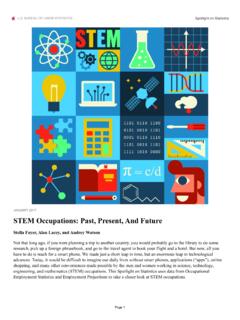Transcription of Occupational Requirements Survey - Bureau of Labor …
1 1 Bureau OF Labor STATISTICST able of Occupational Requirements Survey (ORS) is a Survey of establishments in private industry and state and local government conducted by the Bureau of Labor Statistics (BLS). The ORS publishes information about job Requirements , including the physical demands; environmental conditions; education, training, and experience; as well as cognitive and mental Requirements . This Handbook of Methods explains the process and concepts for the 2019 23 reference period Requirements Survey Quick Facts: Occupational Requirements SurveySubject areasJob requirementsKey measuresEducation, training, and experienceEnvironmental conditionsPhysical demandCognitive and mental requirementsHow the data are obtainedSurvey of businesses and governmentsClassification systemOccupationPeriodicity of data availabilityAnnualGeographic detailNationalScopeState and local government, Private sectorKey productsNews releasesOccupational group profilesDatabase query toolExcel datasetProgram Bureau OF Labor STATISTICSHANDBOOK OF METHODS ConceptsThe Occupational Requirements Survey (ORS) provides estimates measuring four types of Occupational Requirements : physical demands.
2 Environmental conditions; education, training, and experience; and cognitive and mental Requirements . Survey estimates provide insight into the Requirements of work in the ORS is designed to provide information regarding what is required to perform critical job functions of selected jobs. The Survey does not focus on specific capabilities or experiences that individual workers have if the employer does not require them. For example, a job may require a bachelor's degree, but workers performing the job may have more advanced degrees, such as a doctorate degree ( ). For the purposes of the ORS, the requirement is a bachelor s degree. The distinction is significant because the objective of the Survey is to measure job Requirements , not the characteristics of the workers. See the Data sources section for information on how Occupational Requirements are ORS is a nationally representative establishment-based Survey .
3 Private industry and state and local government establishments in the 50 states and the District of Columbia are eligible for selection. Major exclusions from the Survey are workers in federal and quasi-federal agencies (examples include the military, postal service, and federal reserve), establishments in the agriculture, forestry, fishing, and hunting industry sector, workers employed by private households, contractors (onsite workers at the surveyed establishment but paid by another party [contractor] are not included in data collection from the surveyed establishment), the self-employed, volunteers, unpaid workers, individuals receiving long-term disability compensation, and those working overseas. Individuals who set their own pay, such as business owners, and family members who are paid token wages are also excluded.
4 Employees in sampled jobs must receive market-based payments, such as salary, commission, or hourly wages, from the establishment for services performed in the Labor market and the establishment must pay the employer s portion of Medicare taxes on the worker s concepts and definitionsThese key concepts and definitions explain the ORS sampling, estimation, and publication As defined in the Americans with Disabilities Act of 1990, an accommodation is any change in the work environment or in the way things are customarily done that enables an individual with a disability to enjoy equal employment opportunities. The ORS collects information about how workers are required to perform jobs in support of critical job tasks without accommodations, as not all employers can offer the same accommodations. Cognitive and mental Requirements .
5 The qualifications that workers need to use judgment, make decisions, interact with others, and adapt to changes in a job. For a list of cognitive and mental Requirements and corresponding estimate types, see appendix A in the Calculation job function. The main purpose and the primary pay factor for the job. It consists of critical tasks that are integral to the tasks. Activities workers must perform to carry out their critical job function(s).3 Bureau OF Labor STATISTICSHANDBOOK OF METHODS Duration levels. The scale used to categorize the amount of time a worker performs a physical demand, are exposed to an environmental condition, or the amount of time necessary to complete education, training, and experience Requirements . Most physical demands and environmental conditions are measured using duration ranges.
6 For example, if speaking is required for 1 hour of an 8-hour workday then the associated duration level is occasionally because this level of speaking falls between 2 percent and 33 percent of the workday. For more information see the Calculation , training, and experience. The minimum level of formal education required, credentials necessary, on- the-job training, and prior work experience necessary for average performance in selected jobs. For a list of education, training, and experience Requirements and corresponding estimate types, see appendix A in the Calculation conditions. The various tangible or concrete hazards or difficulties that are in the vicinity of where jobs critical tasks are performed. The ORS program has refined examples and definitions for collection of environmental conditions over time, and a visual overview of environmental elements is available on the Information for Survey Participants section of the website.
7 For a list of environmental conditions and corresponding estimate types, see appendix A in the Calculation A single economic unit that engages in one, or predominantly one, type of economic activity. For private industries in the Survey , the establishment is usually a single physical location, such as a mine, a factory, an office, or a store, where workers produce goods or provide private industry, if a sampled establishment is owned by a larger entity with many locations, only the employment and characteristics of the establishment selected for the sample are considered for the state and local governments, an establishment can include more than one physical location, such as a school district or a police The number of times workers experience a requirement while performing critical tasks. Many cognitive and mental Requirements are measured using frequencies.
8 For example, fast food workers may have their work reviewed more than once per day while software developers may have their work reviewed less frequently, such as less than once per day. The estimates reflect the maximum number of times that the requirement is experienced by workers performing critical or part-time status. For the ORS, full-time or part-time status is based on the establishment's definition of those terms, and not determined by the number of hours employees work. This characteristic is collected for the ORS as described in the Design section and ensures that job Requirements correspond to the selected jobs. However, estimates are not published by this level of Establishments are classified into industries using the 2017 North American Industry Classification System (NAICS). NAICS uses a 6-digit hierarchical coding system to classify all economic activity into 20 industry sectors.
9 Of those 20 sectors, 5 are mainly goods-producing sectors and 15 are entirely service-providing Bureau OF Labor STATISTICSHANDBOOK OF METHODS Job. A position where one or more workers are employed at an establishment. The job is characterized by its critical tasks in support of the critical function(s). The term job refers to a single position in a single establishment, but an establishment may have more than one worker in that job on their payroll. For example, a restaurant may have 20 waiters all serving the same function and performing identical tasks. The ORS considers all 20 of those waiters to be duplicates of the same job at that worksite. Because the ORS measures the Requirements of a job and is weighted by the amount of workers employed in that job, "jobs" and "workers" may be used interchangeably in ORS demands.
10 The physical demands; environmental conditions; education, training, and experience; and cognitive and mental Requirements necessary to perform critical tasks in support of the critical job function(s). These job demands can include observable behaviors such as keyboarding, driving, and standing. These can also include unobservable behaviors such as learning and applying knowledge, and problem The mode is the value that appears most frequently in a job requirement category. In the ORS, modes for certain job requirement categories are calculated so that the user may identify the estimate within a category with the largest weighted number of workers. These estimates are presented in the databases via a A generalized job or family of jobs common to many industries and areas, such as an economist or carpenter.












